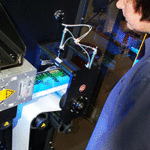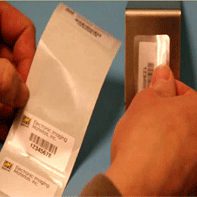
We know you really don’t care HOW your labels are printed….you just want them printed! They need to be made of the right label material and adhesive to work in your application. They need to have durable quality print, in the colors you choose, with the right layout, text and/or barcodes. You want them quickly and in the correct quantities.
The fact is there are several ways to produce labels… some require massive pieces of equipment but there are others that are simple, affordable, and conveniently-sized machines. Electronic Imaging is ever-vigilant to new printing technologies, consistently adding to our arsenal of options, and we even offer printing hardware and software for customers to print their own thermal and thermal transfer labels.
In order to provide labels that are either fully or partially printed, and typically printed in one or more colors—often in sizes or shapes not appropriate for tabletop printers—there are two basic printing methods to use: “Conventional,” long-standing plate printing and “Digital,” the new-age plateless printing.
CONVENTIONAL PRINTING
By “Conventional”, we are talking about the huge, wide presses that require multiple tractor-trailers, a rigger and a lot of real estate to get them installed. Technologies such as offset lithography which emerged in the 1870s and flexography which developed in the early 1900’s are the two most common conventional printing methods. Both of these use print plates with raised images to transfer ink to a substrate and they both come with in-line die-cutting and laminating features. Offset is a bit cheaper to run and is best known in the newspaper and stationery industries because it generates fine images well, while Flexographic (or Flexo) printing works best on label materials, including packaging films and even corrugated boxes. To set up a print job, Conventional presses require a lot of time and material to obtain metal or rubber print plates and then mount and test the plates to ensure print alignment and finally, to check the inks so they flow correctly. This is what adds up to “set-up costs” and they are not cheap – especially since you often have to run hundreds of feet of material to get everything synchronized. The print quality will be dependent not only on the plate, the ink, and the label material, but most importantly on the expertise of the machine operator. With Conventional printing, you have to keep adjusting the ink consistency and keep the plates clean which can seem like a juggling act at times. Granted, when Flexo labels are up and running, the presses can run several hundred feet per minute and the piece cost can drop quickly with high volumes.
Conventional presses can handle a wide variety of label materials and there are extensive choices in ink formulas to print on those materials. Conventional inks come in Pantone PMS colors and if an exact match is needed – say for a company’s logo – a special ink mix can be created. Conventional presses are limited by the number of print stations they have as each color requires a unique print plate and a single ink color. These presses can print one up to 12 colors, but keep in mind that every color adds another print station to the length of the machine.
EIM uses Flexo equipment because it is good for printing large areas of solid color (aka tinting) as well as metallic and opaque white inks. Our presses can work with labels up to 13” wide allowing us to also produce laser sheet-form blank or printed labels.
DIGITAL PRINTING
In contrast “Digital” presses can be more compact but they typically require post-press operations like die cutting and laminating Digital printing encompasses ink, toner and heat fusion technologies as well as inkjet printing. A whole lot less mechanical labor is needed to convert a digital file into a printed label because it eliminates many steps like the ordering and setting up of plates. Besides the ability to get photo-quality images, a big advantage to Digital printing is that you can get acceptable print quality almost immediately and it remains constant throughout a production run. There is very little make-ready to set up and process a Digital print file. Because the setup cost is low and the print speeds may be slower, the cost per label doesn’t really doesn’t decrease with quantity, but it can be cheaper for very small print jobs.
The label materials qualified to use on Digital presses were initially limited and a drawback, but varnishes (aka topcoats) can now be added to make them more print-receptive. Most Digital equipment uses 4-color process inks (Cyan, Magenta, Yellow and Black) to create specific colors and there are a few that can add white and clear coating. Unfortunately, exact color matches may not always be possible with Digital printing since the CMYK colors can only replicate about 40% of the PMS color formulas used in conventional printing. It’s also important to understand that what makes color matching even more complicated is that computer screens are based on RGB colors that can’t be replicated with inks.
Digital printing is the best way to handle small order quantities and rush orders, as well as to help end-users keep their inventory levels lower. It also is the only way to include variable printing such as barcodes, database information or small batches with many layout change-overs. It is perfect for personalization and for proofing. While large-run jobs will continue to dominate the food and beverage industries, there are many other applications for Digital printing including first-run samples and new-to-market product releases.
According to the Tag and Label Manufacturers Institute, Inc. in their North American Digital Label Study 2015, the number of Digital full-color presses installed by label producers officially outpaced Conventional label equipment this past year. Projections indicate that by 2020, only one of every four presses sold in North America will be of Conventional design. That means a whole lot more label convertors will be focusing on Digitally-printed products. Considering this type of equipment was only developed in the mid-1990s, that’s impressive growth – especially when much of the older technologies have been around for a very long time.
While there are over 60 digital label printer models on the market and the largest percentage are inkjet printers, EIM chose a UV Inkjet Digital press that produces extremely durable, UV light and chemical-resistant labels that eliminate the need for lamination.

When trying to decide whether to have your labels printed by Conventional or Digital methods, it’s always best to pick a label company that offers both technologies – and that is exactly what EIM does! We will guide you to make the best label-buying decisions – by looking at print quality, color matching, label material options, delivery time and cost. If you would like to know more about our printing options, contact our Label Experts.




